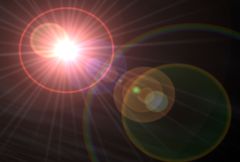S_LensFlare
Renders a lens flare image over the background clip, aligning various flare elements between the hotspot and pivot locations. Use the Lens menu to select different types of lensflares.In the Sapphire Lighting effects submenu.
Inputs:
- Background: The current layer. The clip to apply the lens flare over.

|